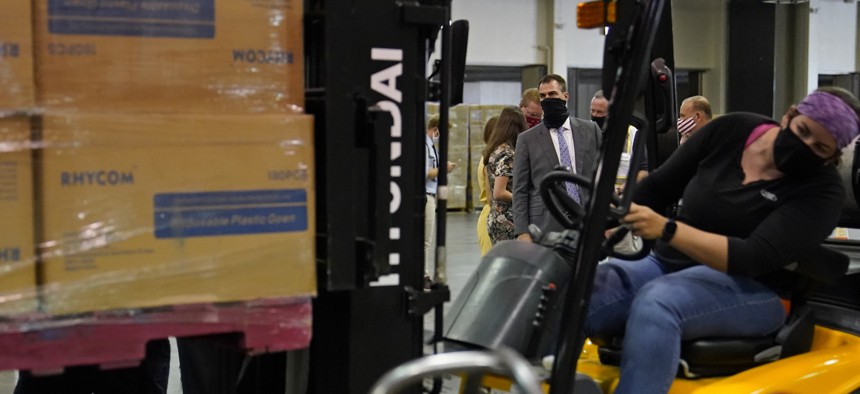States Are Getting Close to Spending Down Federal Covid Aid

Oklahoma Gov. Kevin Stitt, rear, watches as a forklift operator loads boxes of PPE for Edmond Public Schools at the Central Oklahoma PPE distribution warehouse on Aug. 18, 2020, in Oklahoma City. AP Photo/AP Photo/Sue Ogrocki
Two surveys of state and local officials find that states and local governments are using up the money, but that restrictions on how it can be spent have been problematic.
The vast majority of the money states received from a $150 billion pot of federal coronavirus aid is getting put to use, but officials responding to two recent surveys indicated that it would be helpful if the federal government provided more flexibility with how the funds can be spent and extended an end-of-year deadline for using the money.
A National Governors Association survey, based on responses from governor’s offices in 42 states and territories, found that on average 89% of the money states received from the CARES Act’s Coronavirus Relief Fund has been allocated and about 62% of funds obligated.
Allocated here means that the state has divided up the funding among agencies, local governments and for programs like financial assistance to businesses, individuals and nonprofits. Obligated refers to goods or services purchased, but not necessarily received or paid for yet.
Nearly three quarters of respondents to the NGA poll said changing Treasury Department guidelines for the funds slowed how quickly the money could be allocated and used. And although all respondents said they intended to spend the money by a Dec. 30 deadline, 71% said they’d like to see that cutoff date extended into next year.
Survey findings from August detailed in a new Government Finance Officers Association report show that just over half of the state and local governments that responded said the Treasury guidance for how the money could be used was either “somewhat” or “very” unclear.
And 62% of respondents said that the guidance and frequently asked questions documents Treasury issued were the “biggest challenge” in spending their relief funds.
The guidance and frequently asked questions documents have been updated multiple times, including as recently as September, after the GFOA survey was conducted.
Three quarters of those responding to the survey said restrictions on the use of the funds—including the inability to use the money to replace lost revenue and the year-end deadline for using the money—were the biggest challenge in spending the federal aid.
Among the 22 states, 55 counties and 24 cities that responded to the GFOA survey, 82% anticipated spending all of their relief fund dollars before the December deadline, while 16% were uncertain about whether they would spend all the money by then.
It remained unclear on Wednesday whether Democrats and Republicans in Congress would be able to agree before Election Day on federal relief legislation that might provide more aid to state and local governments, or loosen restrictions imposed on the CARES Act funds.
Senate Majority Leader Mitch McConnell has urged the White House against backing a large deal, as Senate Democrats blocked a skinnier package from passing. House Speaker Nancy Pelosi, a Democrat, remained in negotiations this week with the Trump administration.
Sixty percent of respondents to the GFOA survey said they weren’t confident that the federal response to the virus would be proportional to the needs states and localities will have for the rest of the pandemic, while 91% said their state or jurisdiction would benefit from more aid.
The Coronavirus Relief Fund was a key source of federal aid that the CARES Act provided to state and local governments. It included $139 billion for states and larger-sized cities and counties, as well $11 billion for Washington, D.C., territories and tribal governments.
Bill Lucia is a senior reporter for Route Fifty and is based in Olympia, Washington.
NEXT STORY: Local and State Governments Spent $9 Billion on Small Business Aid






